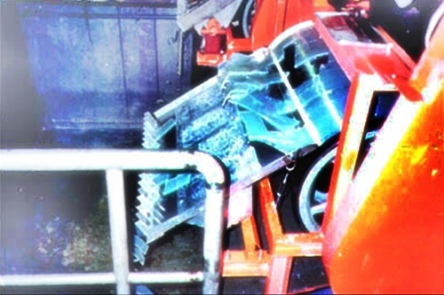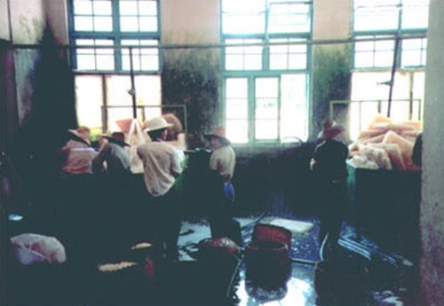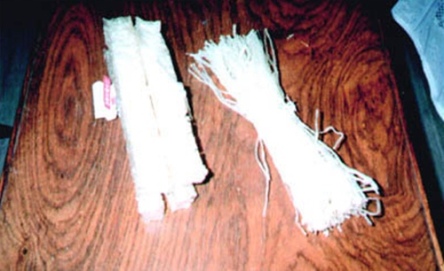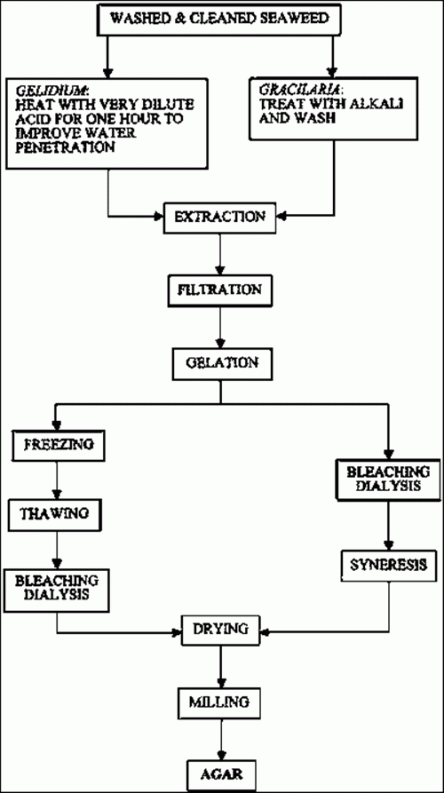Food grade agar A short and simplified description of the extraction of agar from seaweeds is that the seaweed is washed to remove foreign matter and then heated with water for several hours. The agar dissolves in the water and the mixture is filtered to remove the residual seaweed. The hot filtrate is cooled and forms a gel (jelly) which contains about 1 percent agar. The gel is broken into pieces, and sometimes washed to remove soluble salts, and, if necessary, it can be treated with bleach to reduce the colour. Then the water is removed from the gel, either by a freeze-thaw process or by squeezing it out using pressure. After this treatment, the remaining water is removed by drying in a hot-air oven. The product is then milled to a suitable and uniform particle size.
However, for a better understanding of the process, some of the details and difficulties need to be described.
There are some differences in the treatment of the seaweed prior to extraction, depending on the genus used. Gelidium is simply washed to remove sand, salts, shells and other foreign matter and is then placed in tanks for extraction with hot water. Gracilaria is also washed, but it must be treated with alkali before extraction; this alkaline pre-treatment causes a chemical change in the agar from Gracilaria, resulting in an agar with an increased gel strength. Without this alkaline pre-treatment, most Gracilaria species yield an agar with a gel strength that is too low for commercial use. For the alkali treatment, the seaweed is heated in 2-5 percent sodium hydroxide at 85-90°C for 1 hour; the strength of the alkali varies with the species and is determined by testing on a small scale. After removal of the alkali, the seaweed is washed with water, and sometimes with very weak acid to neutralize any residual alkali.
For the hot-water extraction, Gelidium is more resistant and extraction under pressure (105-110°C for 2-4 hours) is faster and gives higher yields. Gracilaria is usually treated with water at 95-100°C for 2-4 hours. The remainder of the process is the same for both types of raw material. The hot extract is given a coarse filtration to remove the seaweed residue, filter aid is added and the extract is pumped through a filter press equipped with a fine filter cloth. The extract is thick and will gel if allowed to cool, so it must be kept hot during the filtration processes.
The filtrate is now cooled to form a gel, which is broken into pieces (Figures 7 and 8). This gel contains about 1 percent agar. The remaining 99 percent is water that may contain salts, colouring matter and soluble carbohydrates. The gel may be treated with bleach to reduce any colour, washed to remove the bleach, and allowed to soak in water so that most of the salts can be removed by osmosis. The wash waters are drained and the remainder of the process is concerned with the removal of the 99 percent water in the gel. Either of two methods can be used for this.
The original method of water removal is the freeze-thaw process. The gel is slowly frozen so that large ice crystals form. The structure of the gel is broken down by the freezing so that when the material is thawed most of the water drains away, leaving a concentrated gel that now contains about 10-12 percent agar (this means about 90 percent of the original water content has been removed, and with it went a high proportion of any salts, soluble carbohydrates and soluble proteins that may have been present in the gel). Sometimes this gel is placed between porous filter cloths and squeezed in a hydraulic press to remove more water. However, this is a slow process, and usually the thawed material is simply drained and placed in a hot-air dryer. After drying it is milled to the required particle size, usually about 80-100 mesh size. Because of the refrigeration costs, this freeze-thaw process is relatively expensive, compared to the alternative described next.
Sometimes the thawing is accelerated by washing the frozen blocks of gel with large quantities of water (Figure 9), but this adds to the already large water consumption of the process.
The alternative process relies on synaeresis. This is the term used to describe the separation of liquid from a gel. A common example is that of a partly used jar of jam or preserves that is left standing for several days: pools of liquid can often be seen at the surface. However, for the agar gel, pressure is used to force the separation of the liquid. The equipment used is based on the following. Two grooved metal plates are covered with porous cloth and the 1 percent agar gel is placed between the cloths, like a sandwich with metal plates on the outside, then the layers of cloth, with the gel in the middle. Pressure is applied to the metal plates and very slowly increased over about 24 hours, forcing liquid out of the gel, through the cloths, down the grooves of the metal plate and away to a drain. The piece of equipment contains about fifty of these sandwich-type units, all in a vertical plane, all being placed under pressure by one hydraulic ram (Figure 10). At the end of the time, the pressure is released, the metal plates are separated and the remaining gel, now containing about 20 percent agar, is peeled off the porous cloth (Figure 11). It is shredded and dried in a hot-air oven before being milled to the required particle size, usually about 80-100 mesh size. With no refrigeration required, the energy consumption is obviously much lower than for the freeze-thaw method, and, since more water has been removed, less soluble matter remains, so the agar is more pure. Less energy is also needed in the drying process since less water is being removed. This process based on synaeresis has been widely adopted by large agar producers who can afford the higher capital costs for this equipment.
A large and reliable freshwater supply is a requirement for an agar factory. Water consumption is high and the processing of Gracilaria requires more than for Gelidium. Higher water consumption also means larger quantities for waste disposal, so recycling of water is becoming more necessary, depending on the location of the factory.
For further details
Detailed information on the commercial extraction process is not easily available. There are several short publications on the results from laboratory-scale extractions, but commercial agar producers are generally secretive about the details of their processes. Armisen and Galatas (1987) is one of the few publications that gives some details, but there are still many gaps, particularly in the conditions of the alkali treatment and the subsequent hot water extraction; nevertheless, it is the best starting point. The original print version may not be readily available but it can be read and downloaded from the FAO Web site (see References 2 – Internet sources). A later book chapter by the same authors, Armisen and Galatas (2000) gives a useful comparison of the freeze-thaw and synaeresis methods for removing water from the agar gel. Nussinovitch (1997: 4-5) also has a few useful details about extraction.
Agar strips
Agar for use in food is sold in two forms: strip agar and agar powder. The powder is produced by the method previously described. Agar strip, sometimes called natural agar, is produced on a small scale in China, Japan and the Republic of Korea by the old, traditional method. Gelidium must be used; it was the only raw material used before the Second World War. It is boiled for several hours in water, acidified by the addition of either vinegar or dilute mineral acid. The hot extract is filtered through cotton cloth, then poured into wooden trays to cool and form a gel. The gel is extruded to produce spaghetti-type strips about 30 cm long. The strips are placed outside at night to freeze and allowed to thaw in the day, so water is released and runs off, leaving a more concentrated gel. This process can be repeated, or modern refrigeration can be substituted. The strips are dried in the sun, which also bleaches the strips. Strips are assembled into bundles and sold for domestic use (Figure 12). Prior soaking makes them easier to dissolve in boiling water.
Bacteriological agar
This can only be made from species of Gelidium because the resulting agar has a low gelling temperature (34-36°C) that allows the addition of other materials to the agar with a minimum risk of heat damage. Gracilaria and Gelidiella give agars that gel at 41°C or higher. “Bacto” agars must not contain anything that might inhibit the growth of bacteria, such as trace metals, soluble carbohydrates or proteins, nor should they contain any bacterial spores. They must not interact with any materials that must be added as nutrients for the bacteria under study. The gels must be strong and have good clarity. Manufacturers of bacteriological agar keep all processing details confidential. However, recently Kim et al. (2000) published details [in Korean] of a pilot-scale preparation that they claim gave a product that is superior to commercial bacteriological agar. Armisen and Galatas (1987) and Armisen (1997) discuss the necessary specifications for bacteriological agar.
Agarose
Agar can be divided into two principal components: agarose and agaropectin. Agarose is the gelling component; agaropectin has only a low gelling ability. There are several methods of producing agarose; many rely on removing the agaropectin from the agar. There are only a small number of processors who produce purified, high quality agarose for a small but growing market, mainly in biotechnology applications. These processors use good quality agar as their starting material rather than seaweed, and are often not in the seaweed processing business. Armisen and Galatas (1987) summarize the methods that have been used to isolate agarose from agar, and discuss the specifications expected for a high quality agarose. (Source FAO)






